Description  The beaver is North America's largest rodent and is built for life in the water. Adults can be up to four feet long and weigh over 60 pounds. The beaver has webbed hind feet and a large, flat, nearly hairless tail. It uses its tail to help maintain its balance when it is gnawing on trees. It will also slap its tail against the water to signal danger or to warn away predators. The beaver has short front legs with heavy claws. Their rear legs are longer, and they use their rear webbed feet help propel themselves through the water. When the beaver is under water, its nose and ears close up and a special membrane covers its eyes. The beaver is North America's largest rodent and is built for life in the water. Adults can be up to four feet long and weigh over 60 pounds. The beaver has webbed hind feet and a large, flat, nearly hairless tail. It uses its tail to help maintain its balance when it is gnawing on trees. It will also slap its tail against the water to signal danger or to warn away predators. The beaver has short front legs with heavy claws. Their rear legs are longer, and they use their rear webbed feet help propel themselves through the water. When the beaver is under water, its nose and ears close up and a special membrane covers its eyes.
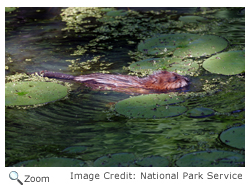 It has dark brown fur on its back and sides and lighter brown fur on its chest and belly. The beaver waterproofs its thick fur by coating it with castoreum, an oily secretion from its scent glands. The beaver has a thick layer of fat under its skin that helps keep it warm underwater. Beavers have long sharp upper and lower incisor teeth that they use to cut into trees and woody vegetation. These teeth grow throughout the beaver's life. It has dark brown fur on its back and sides and lighter brown fur on its chest and belly. The beaver waterproofs its thick fur by coating it with castoreum, an oily secretion from its scent glands. The beaver has a thick layer of fat under its skin that helps keep it warm underwater. Beavers have long sharp upper and lower incisor teeth that they use to cut into trees and woody vegetation. These teeth grow throughout the beaver's life.
Range  The beaver can be found throughout North America, except for most of Florida, the desert Southwest, central and southern Mexico, and the northern most parts of Alaska and Canada. By the late 1800s, the beaver had almost completely disappeared from New Hampshire due to trapping. Between 1926 and 1930, six beavers were released into the wild in central New Hampshire. In 1940, 48 more beavers were released, and the beaver population began to grow. Today, the beaver is found throughout New Hampshire. The beaver can be found throughout North America, except for most of Florida, the desert Southwest, central and southern Mexico, and the northern most parts of Alaska and Canada. By the late 1800s, the beaver had almost completely disappeared from New Hampshire due to trapping. Between 1926 and 1930, six beavers were released into the wild in central New Hampshire. In 1940, 48 more beavers were released, and the beaver population began to grow. Today, the beaver is found throughout New Hampshire.
Habitat
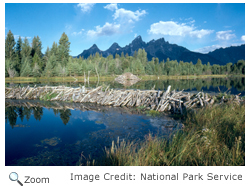 Beavers live near rivers, streams, ponds, small lakes, and marshes. They build lodges of sticks and mud on islands, on pond banks, or on lake shores. Beaver dams are domed-shaped and can be up to ten feet tall. Beaver lodges have one large central chamber and one or two entrances. The floor of the chamber is a little bit above the water and is usually covered in woodchips to absorb moisture. A vent in the lodge lets in fresh air. Not all beavers build lodges; some beavers build burrows in the banks of rivers. Beavers live near rivers, streams, ponds, small lakes, and marshes. They build lodges of sticks and mud on islands, on pond banks, or on lake shores. Beaver dams are domed-shaped and can be up to ten feet tall. Beaver lodges have one large central chamber and one or two entrances. The floor of the chamber is a little bit above the water and is usually covered in woodchips to absorb moisture. A vent in the lodge lets in fresh air. Not all beavers build lodges; some beavers build burrows in the banks of rivers.
Diet 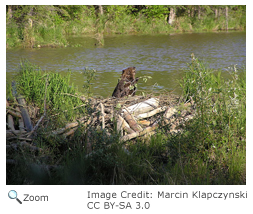 Most of the beaver's diet is made up of tree bark and cambium - cambium is the soft tissue that grows under the bark of a tree. They especially like the bark of willow, maple, birch, aspen, cottonwood, beech, poplar, and alder trees. Beavers also eat other vegetation like roots and buds and other water plants. The beaver has a specialized digestive system that helps it digest tree bark. Most of the beaver's diet is made up of tree bark and cambium - cambium is the soft tissue that grows under the bark of a tree. They especially like the bark of willow, maple, birch, aspen, cottonwood, beech, poplar, and alder trees. Beavers also eat other vegetation like roots and buds and other water plants. The beaver has a specialized digestive system that helps it digest tree bark. |
|
Life Cycle 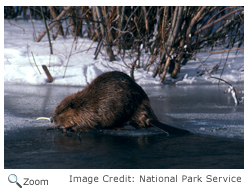 Beavers mate for life, but if one mate dies, the other one finds another mate. Beavers mate when they are about three years old. Mating season runs from January and March in cold regions and in late November or December in the south. Gestation lasts about three months, and females have one litter of kits a year between April and June. Before birth, the female makes a soft bed in the lodge. The babies' eyes are open when they are born, and they can swim within 24 hours of birth, and they will be exploring outside the lodge with their parents within a few days. Beavers mate for life, but if one mate dies, the other one finds another mate. Beavers mate when they are about three years old. Mating season runs from January and March in cold regions and in late November or December in the south. Gestation lasts about three months, and females have one litter of kits a year between April and June. Before birth, the female makes a soft bed in the lodge. The babies' eyes are open when they are born, and they can swim within 24 hours of birth, and they will be exploring outside the lodge with their parents within a few days.
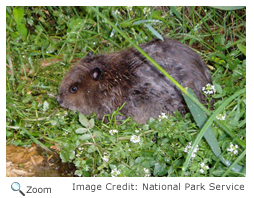 Young beavers are weaned in about two weeks. Both the male and the female take care of the young beavers. They stay with their parents for two years. Beavers can live to be 20 years old. Young beavers are weaned in about two weeks. Both the male and the female take care of the young beavers. They stay with their parents for two years. Beavers can live to be 20 years old.
Behavior 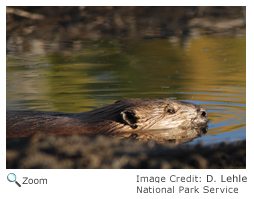 Beavers live in family groups or colonies. A colony is made up of a breeding male and female beaver and their offspring. Beavers are very territorial and protect their lodges from other beavers. They mark their territory by building piles of mud and marking it with scent. Beavers live in family groups or colonies. A colony is made up of a breeding male and female beaver and their offspring. Beavers are very territorial and protect their lodges from other beavers. They mark their territory by building piles of mud and marking it with scent.
Beavers can have both a positive and a negative impact on the environment. When beavers build dams, they create new wetland environments for other species. These wetlands can help slow erosion, raise the water table, and help purify the water. Beavers can play a major role in succession. When beavers abandon their lodges and dams, aquatic plants take over the pond. Eventually, shrubs and other plants grow, and the area will become a meadow. The shrubs in the meadow will provide enough shade to allow tree seedlings to grow. Once the trees grow, they will take over, and the land will turn into a woodland area.
Beaver dams can also cause problems. Dams can slow the flow of water in streams and cause silt to build up, and some other species can loose habitat. Dams can also cause flooding in low-lying areas.
Video Credit: US Fish and Wildlife
|